Saving Your At-Risk Customers with a Product Education Journey
We are excited to be partnering with Autopilot on an integration that allows our mutual customers to execute faster and smarter on their marketing and products.
With the combination of Heap and Autopilot, you can more quickly answer questions such as:
How effective are different Autopilot journeys at gaining conversions?
What email content is most effective at driving conversion?
Does engagement in a journey improve retention over time?
While there are many reasons why Heap and Autopilot are better together, we wanted to focus on improving the engagement of one customer group for this post: at-risk customers.
At-risk customers
There are a lot of ways to use Heap and Autopilot to improve at-risk customer engagement.
But first, what’s an at-risk customer?
They’re customers close to leaving you. Their product usage has tailed off to near churn levels and they haven’t found your product all that valuable so far.
They’re often a result of poor product education. Uneducated on what features you offer, how to best use your product, and how they can get the most value out of your product, they’re unlikely to stick around.
There are some situations where there’s nothing you can do to bring a customer back from the brink of churning:
A customer has hit a rough time and is tightening their tool budget across the board or has decided to lay off team members important to your product, so there’s less need.
They’ve made a big change to business strategy and don’t need your product anymore.
They’ve bought a competing product and are phasing yours out.
Otherwise, it’s absolutely worth the effort to make at-risk customers loyal. They have already bought from you and may be close to churning, but still see enough value to keep using and paying for your product.
Read our guide to Customer Churn.
How to identify them
Before you start sending Autopilot journeys to increase engagement, you need to build a profile of an at-risk customer and identify which of your customers are actually at risk of churning.
For this post, we’ll use the fictitious company, FlickServer, as an example. FlickServer is a SaaS video hosting product that has a churn problem. FlickServer’s value is in its ability to act as a “customized YouTube” for businesses that produce a lot of video, but want more control over the video hosting process than YouTube allows.
We’ll start the process of building FlickServer’s at-risk customer profile by looking at their churned customer data to identify trends.
Why start with churned customers? They’re what you’re afraid your at-risk customers will become and you’ll find the patterns in how they use your product to get at-risk customers more engaged.
We’ll use Heap to create a segment of FlickServer churned customers to analyze.
Saving Your At Risk Customers
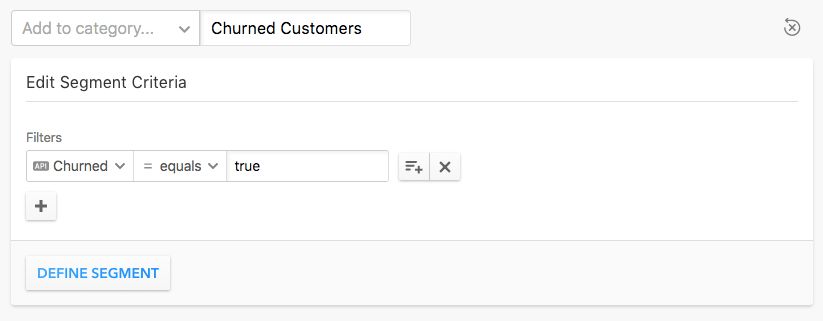
Now you have a list, it’s time to look for usage (or lack thereof) patterns. Depending on the size of your list, you may find patterns to form a few different groups around. For this post, we’ll assume there’s only one group of at-risk customers at FlickServer for simplicity’s sake.
Create a list of your key features and product milestones and look for patterns of usage. What are the key actions needed to experience your product’s core value?
In FlickServer’s case, the core actions customers need to take to find value are:
Connecting their analytics account to their FlickServer account. In earlier research, we found that connecting their analytics accounts allows our customers to get insights into how their videos are affecting the rest of their marketing efforts, leading to better video strategies and seeing more value from our product.
Uploading at least 5 videos. We previously discovered that once a customer uploads five videos, they’re 84% more likely to stay a customer. With this in mind, we’ll look at how many videos churned customers have uploaded to see if this is an area for improvement.
Customize the look of their site. During another research project, we discovered that our best customers have customized their site from the default configuration to better match their branding.
Looking over our data, it turns out that while 35% of our churned customers didn’t connect their analytics to their account and 29% didn’t upload 5 videos, a whopping 72% never customized their site.
Talk to them and figure out why they churned
We know that 72% of our churned customers never touched a site customization feature, but we don’t know what issues kept them from using these features.
That’s why we want to reach out to our customers to see why they churned once we’ve learned their product behaviors.
You may be thinking: “These customers didn’t want my product anymore, why would they want to talk to me?”, but you’d be surprised how many are willing to talk.
The right customers
Keep in mind while doing your research that you probably don’t want all of your churned customers on the list. Some of them weren’t a good fit for your product in the first place.
For some customers, your product will always be too expensive. For others, you may have made a business model change or are trying to sell larger deals to larger customers and some of those customers churned before the change.
The customers left should be the type you actually want to keep.
FlickServer research
After talking to churned customers about why they decided to churn, we have the following reasons why customers didn’t use any customization options:
Many didn’t realize there was an option to customize their site. Some intended to make changes but had their focus shifted and they then forgot about the feature.
A portion knew the feature existed but didn’t appreciate the value.
Some saw the value, but just didn’t have the time.
Others saw the value but thought it was too advanced to do themselves.
Luckily, these are easy fixes with an Autopilot Journey.
Now that we’ve identified our at-risk customers, we’ll create a segment in Heap to send our journeys to.
Heap Customer Journey - At Risk Customers
Heap Customer Journey - At Risk Customers

Driving more site customization with Autopilot Journeys
Site Customization with Autopilot Journeys
Site Customization with Autopilot Journeys
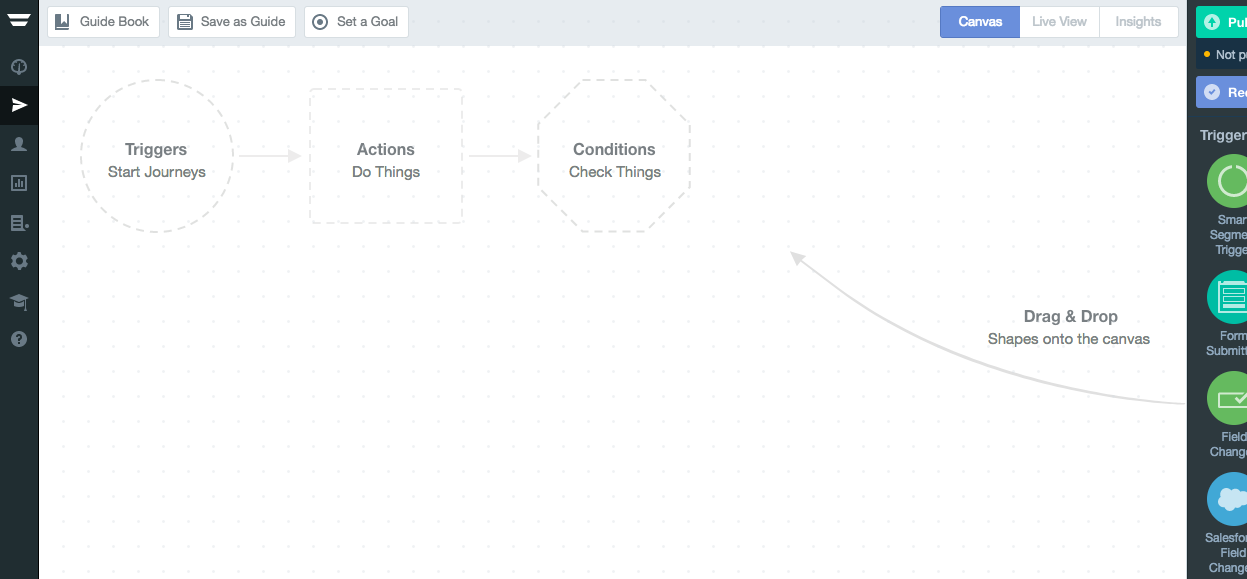
In an ideal world, every one of your customers would diligently go through your onboarding process and read all your help docs to become an expert on your product
In reality, very few of your customers will ever take that kind of effort to get to know your product and will instead stumble their way through usage.
The good news is that a “product education” journey can go a long way to helping more fully understand where they can get value from your product.
Before we jump into AutoPilot and start building our journey, let’s plan it out. Since FlickServer is a B2B web SaaS product, we’ll use emails for our journey, though Autopilot offers several other options such as SMS, Mobile Notifications, and Slack messages.
We have four reasons for the lack of customization among churned customers, so we’ll have an email for each case as well as a final email that goes out only if the previous four haven’t done their job.
How can we address each reason?
Didn’t know feature existed – Send a short email about the product that points to our launch blog post that explains the value, the different options, and has a walkthrough on customization at the end.
Think customizing is too complicated – Point them to our documentation on changing the colors of their site, their site’s layout, and our tutorials.
Don’t have the time – Send them to our landing page about our new service where we have a designer help them customize their site for a $299 fee.
Don’t see the value – Show them some social proof with our gallery of highlighted customer sites and a link or two to customer stories or case studies about the results customization brought.
We’ll set our journey to trigger after a certain amount of days without the customer having used any customization features. Looking at our data, it turns out that our most engaged customers tend to customize their site within 10 days of signing up and there’s a sharp increase in customers churning starting at the 45 day mark.
With these numbers in mind, we’ll start our journey on our customer’s 10th day if they haven’t used any customization features and send emails on a 7 day cadence to get all 5 emails in before the 45 day mark.
For our trigger, we’ll use Autopilot’s page visited trigger and the confirmation page that customers see after changing their customization settings.
Pageview Trigger Autopilot
Pageview Trigger Autopilot
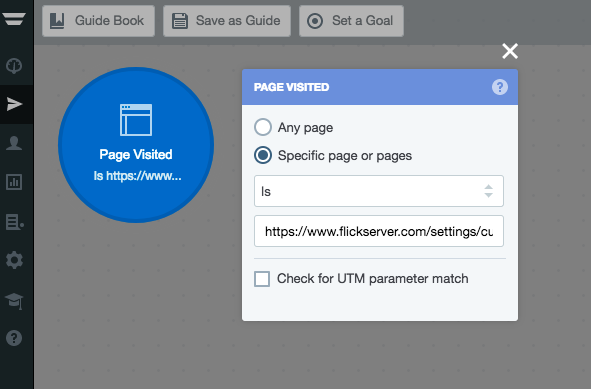
For our first email, we’ll address one of the easier reasons to deal with: customers who don’t know the feature exists.
FlickServer Email Example 1
FlickServer Email Example 1
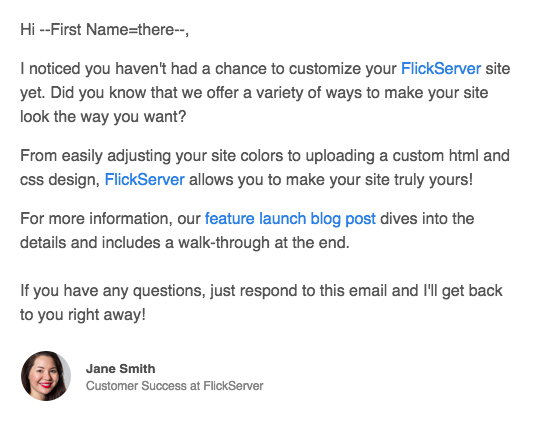
Next, we want to address the users who think customizing their site is too complicated for them to take on. We’ll point them to our documentation, and will focus on our two less advanced options, changing layout colors and changing the layout template itself.
Email 2 FlickServer
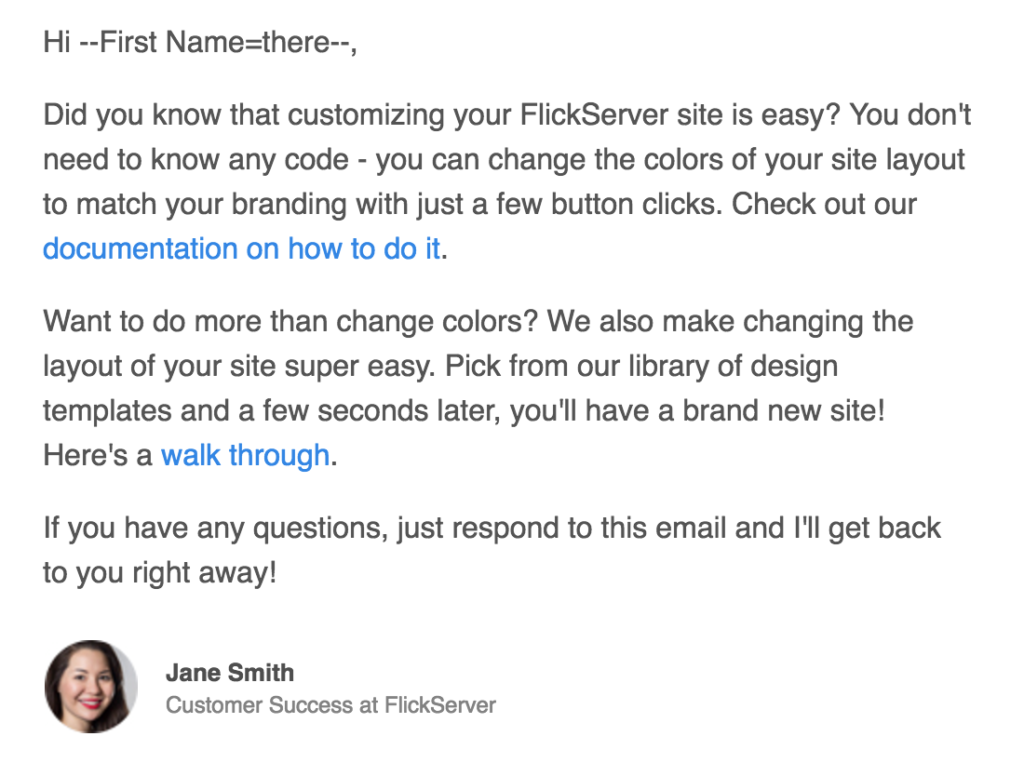
The next group of at-risk customers we’ll address already know about our customization features, but are too busy to go through and use them themselves. Enter our recently launched site customization service!
Email 3 FlickServer At Risk Customers
Email 3 FlickServer At Risk Customers
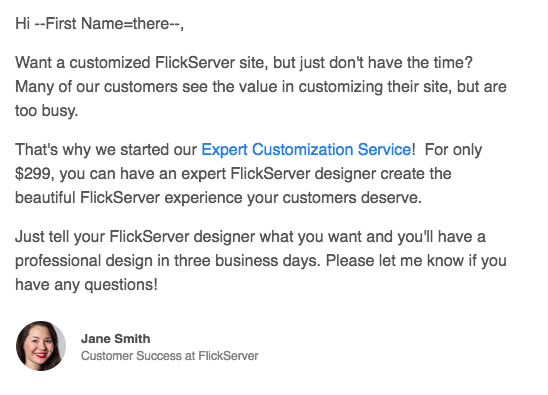
Our final group is familiar with our customization features and our customization service, but they’re not convinced these features are worth the time or money to use. With this email we want to show social proof and give an example of the value that our customers get by customizing their site.
Email 4 FlickServer
Email 4 FlickServer
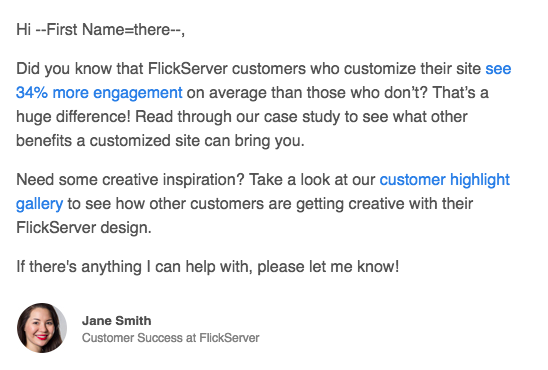
And finally, we have our fifth email in our journey, which we send out if the customer has not been convinced by the previous 4 to use one of our customization features. Our fifth email will be our last attempt to get our at-risk customer engaged with our customization features.
Email 5 FlickServer
Email 5 FlickServer

Conclusion
Bringing back at-risk customers is just one of the many great use cases for combining Autopilot and Heap.
With our products together, you can figure out what works and what doesn’t faster, improving your customer experience and your bottom line. For more information on how the integration works, take a look at our documentation.
Thanks for reading!